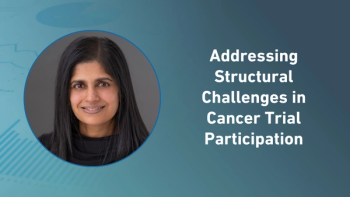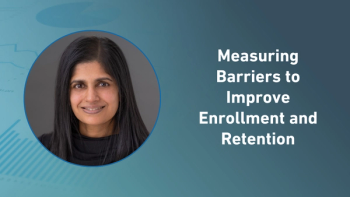Key takeaways
- Once-weekly efsitora may streamline insulin initiation for insulin-naïve type 2 diabetes patients, with comparable glycemic control to daily glargine and reduced need for dose titration.
- QWINT-1’s fixed-dose design simplifies trial logistics and patient adherence, showing low hypoglycemia rates and strong retention across a diverse global cohort.
- Efsitora's safety and efficacy profile across multiple trials (QWINT-1 and QWINT-3) suggests scalability for broader real-world adoption and support for future regulatory submissions.
Detailed findings from the QWINT-1 clinical trial (NCT05662332) show that Eli Lilly’s once-weekly efsitora, administered in a fixed-dose regimen, demonstrated noninferiority to once-daily glargine in reducing glycated hemoglobin (HbA1c) in patients with type 2 diabetes who had not previously received insulin.1
Results from the trial, published in the New England Journal of Medicine (NEJM), may signal a meaningful shift in how insulin therapy is initiated and managed for people with type 2 diabetes, offering a glimpse into a potentially simpler and safer alternative to daily regimens.
Potential for simpler insulin initiation in insulin-naïve adults
“In previous treat-to-target trials, adjustments to the dose of basal insulin have been made at least weekly, according to fasting blood glucose levels,” the study authors wrote. “A fixed-dose regimen of insulin efsitora alfa (efsitora), a once-weekly basal insulin, may provide a benefit in adults with type 2 diabetes who have not received previous insulin therapy.”
In the QWINT-1 study, efsitora displayed noninferiority to glargine in reducing HbA1c over 52 weeks in insulin-naïve adults. The majority of participants (76%) remained on one of four fixed doses for the duration of the trial, achieving glycemic control comparable to glargine but with fewer dose adjustments and low rates of hypoglycemia (<1 event per participant-year).
Study design and methodology: QWINT-1 trial overview
- QWINT-1 is Phase III, parallel-design, open-label, randomized control study to evaluate the efficacy and safety of efsitora using a fixed dose escalation compared to insulin glargine in insulin-naïve adults with type 2 diabetes.2
- The trial enrolled 795 patients and was conducted across 71 sites in Argentina, Mexico, and the US.
- The study timeline was comprised of a 3-week screening and lead-in period, a 52-week treatment period, and a 5-week safety follow-up period.
- The primary endpoint was change in HbA1c level from baseline over 52 weeks.
- Key secondary endpoints included change from baseline to week 52 in fasting blood glucose level, insulin dose, and Treatment-Related Impact Measure–Diabetes total score.
Clinical outcomes: Comparable glycemic control and lower hypoglycemia risk
In addition to its success in displaying noninferiority to glargine by reducing HbA1c from 8.20% to 7.05%, efsitora demonstrated a number of positive outcomes across fasting blood glucose, insulin dose, and hypoglycemia risk.
- Self-measured fasting glucose decreased to ~127.7 mg/dL with efsitora and ~126.7 mg/dL with glargine by week 52.
- At week 52, mean total insulin dose was lower with efsitora (289.1 U/week; ~41.3 U/day) compared to glargine (332.8 U/week; ~47.5 U/day).
- Clinically significant/severe hypoglycemia occurred at a rate of 0.50 events per participant-year with efsitora vs. 0.88 with glargine (rate ratio: 0.57; 95% CI: 0.39–0.84).
In terms of safety and tolerability, adverse events (AEs) were reported by 59.9% of efsitora patients and 65.1% of glargine patients. Serious AEs occurred in 6.5% of efsitora participants and 5.3% of glargine participants.
QWINT-3 supports long-term efficacy of efsitora in previously treated adults
In September 2024, Eli Lilly shared initial results from QWINT-1 along with another study evaluating efsitora, QWINT-3 (NCT05275400). In QWINT-3, efsitora was compared to once daily insulin degludec for 78 weeks in adults with type 2 diabetes currently treated with basal insulin. Results from QWINT-3 showed efsitora reduced A1C by 0.86% compared to 0.75% for insulin degludec.3
In a press release from the time, Jeff Emmick, MD, PhD, senior vice president, product development, Lilly, said: "Once weekly insulins, like efsitora, have the potential to transform diabetes care as we know it. Many patients are reluctant to start insulin because of the burden it places on them. With a simple fixed-dose regimen, once-weekly efsitora could make it easier for people with diabetes to start and manage insulin therapy, while reducing the impact it has on their day-to-day lives."
References
1. Julie R. Ingelfinger, Clifford J. Rosen, Weekly Insulins and Therapeutic Burden in Type 2 Diabetes, New England Journal of Medicine. https://www.nejm.org/doi/full/10.1056/NEJMe2508147. (2025)
2. A Study of Insulin Efsitora Alfa (LY3209590) Compared to Glargine in Adult Participants With Type 2 Diabetes Who Are Starting Basal Insulin for the First Time (QWINT-1) (QWINT-1). ClinicalTrials.gov. Updated October 30, 2024. Accessed July 10, 2025. https://clinicaltrials.gov/study/NCT05662332
3. Eli Lilly’s Insulin Efsitora Alfa Succeeds in Duo of Type 2 Diabetes Phase III Studies. Applied Clinical Trials. September 6, 2024. Accessed July 10, 2025. https://www.appliedclinicaltrialsonline.com/view/eli-lilly-insulin-efsitora-alfa-type-2-diabetes




